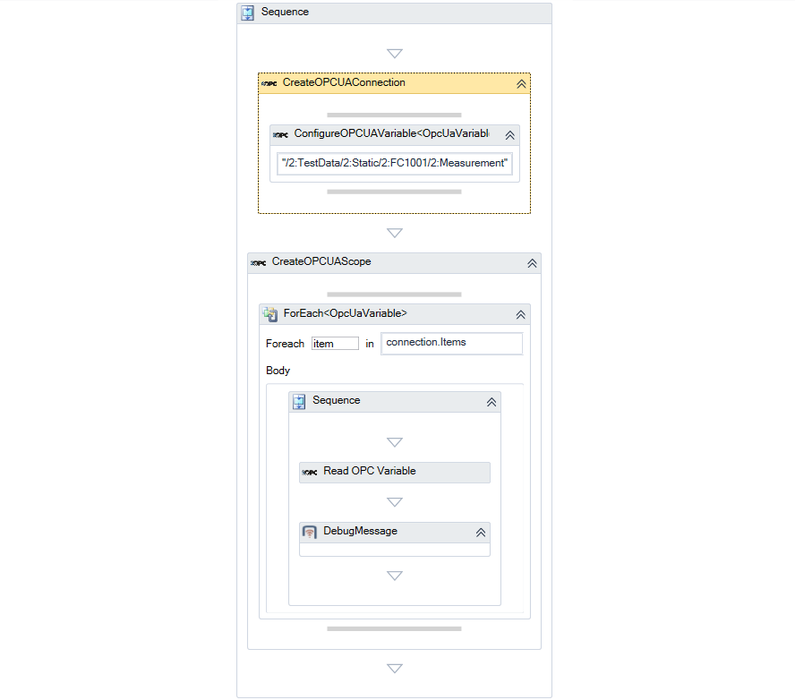Difference between revisions of "Activity:CreateOPCUAScope (Activity)"
| (2 intermediate revisions by the same user not shown) | |||
| Line 1: | Line 1: | ||
| + | The CreateOPCUAScope opens a previously configured [[Activity:CreateOPCUAConnection (Activity)|OPC Connection]], processes variable requests and closes the connection when finished. | ||
| + | |||
| + | =Description= | ||
{{ActivityInfoBox | {{ActivityInfoBox | ||
| title = Configure OPC UA Variable | | title = Configure OPC UA Variable | ||
| Line 10: | Line 13: | ||
}} | }} | ||
| − | + | ===Arguments=== | |
| − | + | ||
| − | ==Arguments== | + | |
{| class="wikitable sortable" | width = "50%" | {| class="wikitable sortable" | width = "50%" | ||
| Line 18: | Line 19: | ||
! Argument!! Type !! Direction !! Purpose | ! Argument!! Type !! Direction !! Purpose | ||
|- align="left" | |- align="left" | ||
| − | | Connection|| OPCUAServerConnection|| In || A valid connection object as produced by a predecessing [[CreateOPCUAConnection (Activity)|OPC Connection]] | + | | Connection|| OPCUAServerConnection|| In || A valid connection object as produced by a predecessing [[Activity:CreateOPCUAConnection (Activity)|OPC Connection]] |
|- align="left" | |- align="left" | ||
| Result|| {{Boolean_MSDN}}|| Out || True if successful, false if failed | | Result|| {{Boolean_MSDN}}|| Out || True if successful, false if failed | ||
|} | |} | ||
| − | ==Usage== | + | ===Usage=== |
This activity is used to open a preconfigured [[Activity:CreateOPCUAConnection (Activity)|OPC Connection]]. It is a nestable activity, which means it can host any amount of sub-activities that will be processed sequentially. The hosted activities are typically [[Activity:AccessOPCUAVariable (Activity)|AccessOPCUAVariable]] activities, either as direct children but also wrapped within looping activities like ForEach or While. When all child activities are processed the OPC connection will be closed again. | This activity is used to open a preconfigured [[Activity:CreateOPCUAConnection (Activity)|OPC Connection]]. It is a nestable activity, which means it can host any amount of sub-activities that will be processed sequentially. The hosted activities are typically [[Activity:AccessOPCUAVariable (Activity)|AccessOPCUAVariable]] activities, either as direct children but also wrapped within looping activities like ForEach or While. When all child activities are processed the OPC connection will be closed again. | ||
| − | + | =Example= | |
The CreateOPCUAScope activity, as used in the larger example "Read value from OPC variable": | The CreateOPCUAScope activity, as used in the larger example "Read value from OPC variable": | ||
[[File:UI_Activity_CreateOPCUAConnection_Example.png|x700px]] | [[File:UI_Activity_CreateOPCUAConnection_Example.png|x700px]] | ||
| + | |||
| + | <headertabs /> | ||
==See also== | ==See also== | ||
| Line 37: | Line 40: | ||
[[Category:OPC]] | [[Category:OPC]] | ||
| − | |||
Latest revision as of 12:39, 23 February 2015
The CreateOPCUAScope opens a previously configured OPC Connection, processes variable requests and closes the connection when finished.

